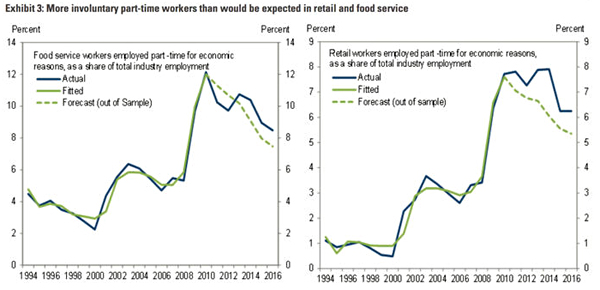Under Obamacare, employers are required to either provide health insurance to their full-time employees or else pay a fine. In 2015, this mandate went into effect for companies with over 100 employees. In 2016 it went into effect for companies with over 50 employees.
A “full-time” employee is one who works 30 hours per week or more, so it makes sense that some small companies might have cut the hours of their full-time employees in order to avoid having to pay for health insurance. But did that actually happen?
This is a surprisingly hard question to answer. There’s some anecdotal evidence from small business owners who say they’ve done exactly that, but only a little. Nor is there much from workers. But really, we’d prefer quantitative evidence anyway. If there are a lot of employers doing this, it should show up in the numbers.
But which numbers? Ideally, we’d like to see evidence of workers getting their work week cut to exactly 29 hours. That would be strong evidence that Obamacare was at fault. But we don’t have those numbers. Alternatively, we could compare adjoining regions with and without the mandate, and compare their rate of part-time workers. If one region stayed steady and the other increased right around 2015 and then again in 2016, Obamacare would be the likely culprit. But the mandate is nationwide, so we can’t do that.
So what can we do? Well, we could create a model of part-time workers that fits the past, and then see how it well it predicts what happened after Obamacare went into effect. A Goldman Sachs economist did just that, and came up with these charts for the food-service and retail industries, the ones that have always been the most resistant to providing their workers with health insurance:

The model says the number of workers who are part-time involuntarily should have followed the green dashed line, but in reality the number only went down as much as the solid blue line. This gap suggests that we have more involuntary part-time workers than we should, which led conservative sites to report that Obamacare is “forcing hundreds of thousands of people into part-time work.” But Michael Hiltzik of the LA Times notes that the author of the report is considerably more circumspect. You can read about it here.
But I think there’s a bigger problem here. The aftermath of the Great Recession has been unique in a lot of ways, which means that models of previous recessions probably aren’t very reliable forecasters. That’s especially true when you’re dealing with very small numbers, as we are here.
And then there’s a yet bigger problem: I don’t think Goldman’s economist even used the right numbers in the first place. His model relies on the number of people who report that they’re working “part-time for economic reasons,” but there are two kinds of these workers. The first are those who can’t find full-time work because the economy is bad. That’s not what we’re looking for. The second are workers who report that they “could find only part-time work.” That’s what we’re after: People who want to work full-time, but have been put on part-time status for reasons other than slack labor conditions.
So did Obamacare cause a change in that number? We don’t have a model, but we don’t need one—at least, not for starters. The first step is much simpler: just look at the trendline and see if there’s any kind of inflection point when the mandate went into effect. Here’s the chart:

I don’t see anything. The 2015 mandate was pretty weak, and I wouldn’t expect that it had much effect. But the 2016 mandate was more serious and applied to more businesses, so I would expect to see something there. And yet…there’s nothing. The trendline doesn’t show any change at all—and certainly nothing like 200-300,000 workers. That would be a big spike on a chart that only goes from 2 million to 2.7 million in the first place.
This is all kind of peculiar. I never bought the conservative arguments of part-time Armageddon, but it makes sense that some employers would try to save money by reducing their number of full-timers. Looking at the data, though, I’m hard pressed to see any effect. If I squint real hard, maybe I can convince myself that the trendline took a jump in Q3 of last year and never fully recovered from it. Or, who knows: maybe that spike in May of 2016 will continue—though it’s not clear why a mandate beginning in January would suddenly cause employers to react five months later.
In any case, those are both nits. As it stands, the evidence suggests almost no effect at all. And that’s something I’d like to understand better. The interesting question here isn’t why part-time employment spiked, it’s why part-time employment didn’t spike. It seems like it should have. Once again—as it’s done before—Obamacare is working even better than I would have expected.













